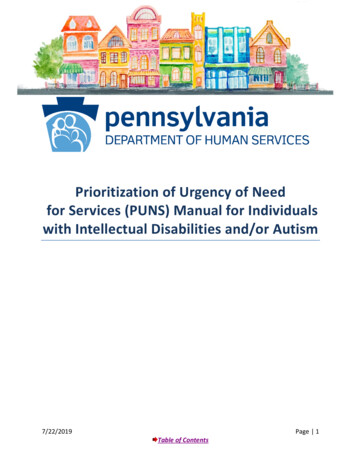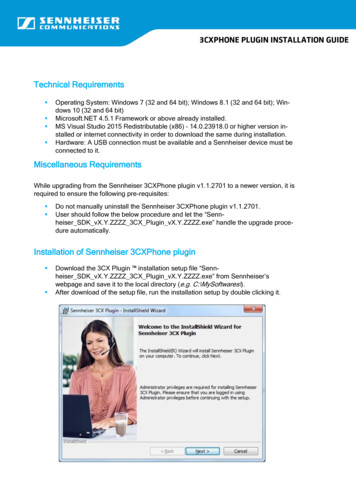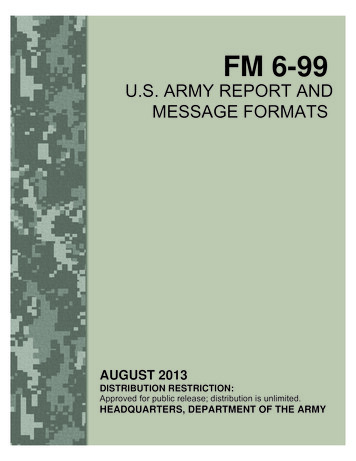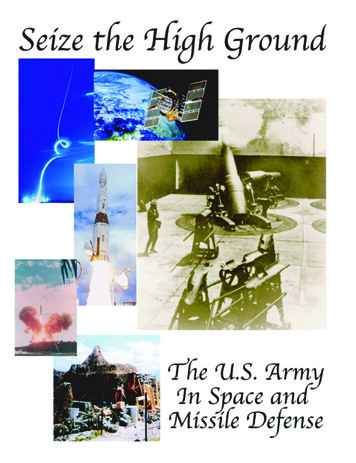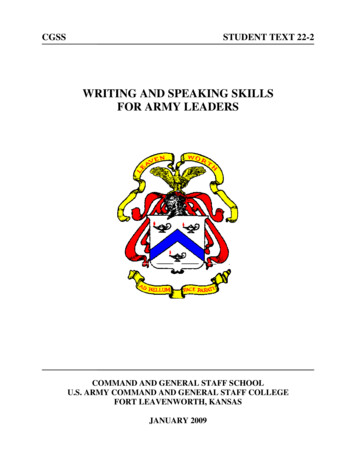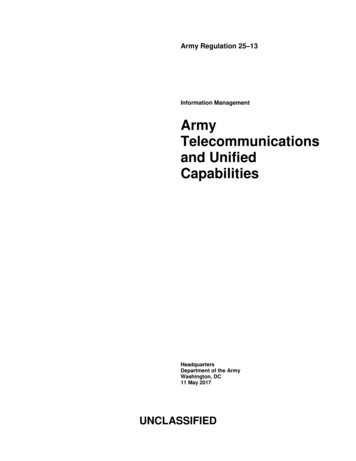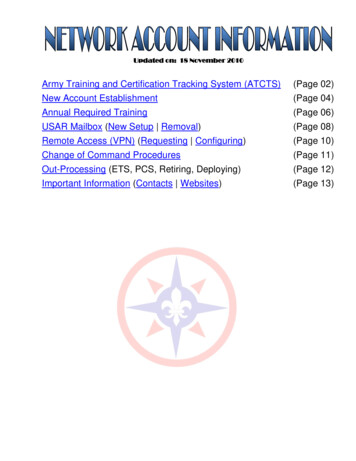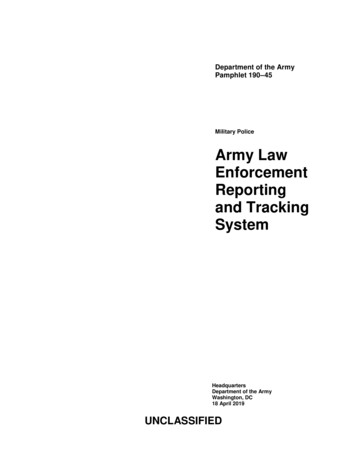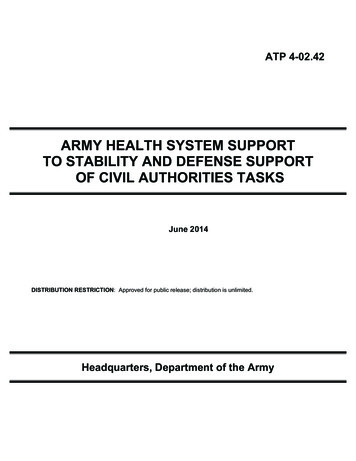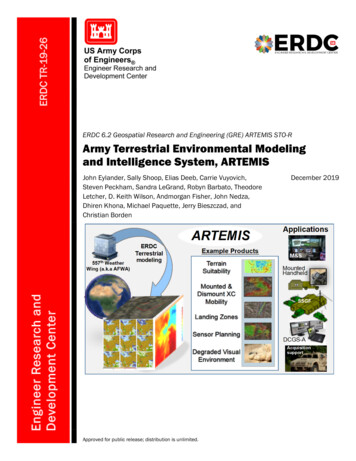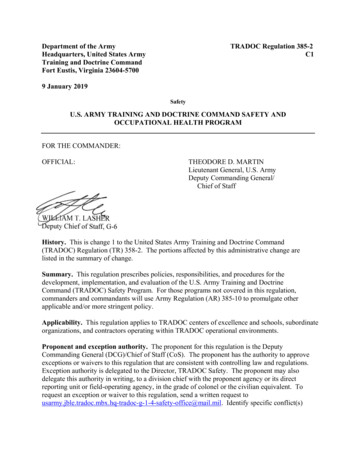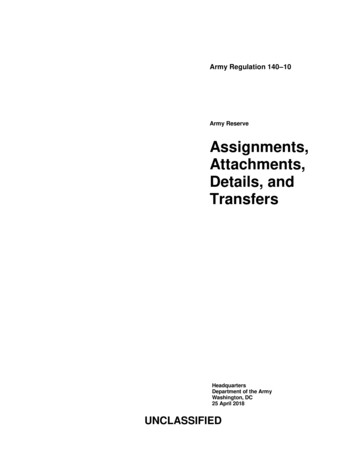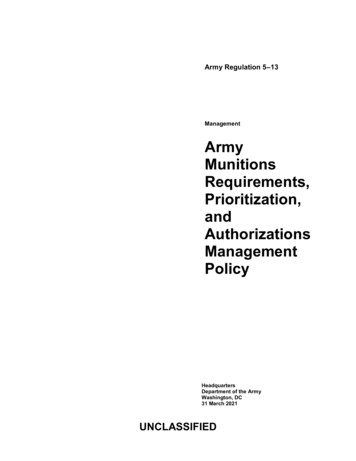
Transcription
Army Regulation rsDepartment of the ArmyWashington, DC31 March 2021UNCLASSIFIED
SUMMARY of CHANGEAR 5– 13Army Munitions Requirements, Prioritization, and Authorizations Management PolicyThis major revision, dated 31 March 2021—oChanges the name of this regulation from Total Army Munitions Requirements and Prioritization Policy to ArmyMunitions Requirements, Prioritization, and Authorizations Management Policy (cover).oUpdates the entire chapter on organizational roles and responsibilities (chap 1).oAdds responsibilities for the Commanding General, U.S. Army Futures Command (para 1– 19).oUpdates the entire chapter on total munitions requirements (chap 2).oUpdates the entire chapter on prioritizing, authorizing, forecasting, requesting, and expending munitions (chap3).oAdds new chapter on the Total Ammunition Management Information System (chap 4).oUpdates timelines for key actions associated with Army munitions requirements, prioritization, and integrationmanagement (app B).oUpdates internal controls, in accordance with AR 11– 2 (app C).
*Army Regulation 5–13HeadquartersDepartment of the ArmyWashington, DC31 March 2021Effective 30 April 2021ManagementArmy Munitions Requirements, Prioritization, and Authorizations ManagementPolicyProponent and exception authority.The proponent of this regulation is theDeputy Chief of Staff, G– 3/5/7. The DCS,G– 3/5/7 has the authority to approve exceptions or waivers to this regulation thatare consistent with applicable law andregulations. The DCS, G– 3/5/7 may delegate this approval authority, in writing, toa division chief within the proponentagency or its direct reporting unit or fieldoperating agency in the grade of colonelor the civilian equivalent. Activities mayrequest a waiver to this regulation byproviding justification that includes a fullanalysis of the expected benefits and mustHistory. This publication is a major re- include formal review by the activity’svision.senior legal officer. All waiver requestsSummary. This regulation prescribes will be endorsed by the commander orpolicies governing the Army’s manage- senior leader of the requesting activityment of requirements, priorities and au- and forwarded through higher headquarthorizations of Department of Defense ters to the policy proponent. Refer to ARmilitary munitions (commonly referred to 25 –30 for specific guidance.as ammunition and explosives) and the Army internal control process.management of the Total Ammunition This regulation contains internal controlManagement Information System.provisions in accordance with AR 11 –2Applicability. This regulation applies and identifies key internal controls thatto the Regular Army, the Army National must be evaluated (see appendix C).Guard/Army National Guard of theUnited States, and the U.S. Army Reserve. It also applies to the U.S. Army Reserve Officer Training Corps and the National Defense Cadet Corps.Supplementation. Supplementationof this regulation and establishment ofcommand and local forms are prohibitedwithout prior approval from the DeputyChief of Staff, G– 3/5/7, available atemail: usarmy.pentagon.hqda-dcs-g-3 -5 7.list.dcs-g3-damo-tra@mail.mil/.Suggested improvements. Usersare invited to send comments and suggestimprovements on DA Form 2028 (Recommended Changes to Publications andBlank Forms) directly to email:usarmy.pentagon.hqda-dcs-g-3 -5 -7.list.dcs-g3-damo-tra@mail.mil/.Committee management. AR 15– 39requires the proponent to justify establishing/continuing committee(s), coordinatedraft publications, and coordinate changesin committee status with the Office of theAdministrative Assistant to the Secretaryof the Army, Department of the ArmyCommitteeManagementOffice(AARP – ZA), 9301 Chapek Road, Building 1458, Fort Belvoir, VA 22060– 5527).Further, if it is determined that an established “group” identified within this regulation, later takes on the characteristics ofa committee, as found in the AR 15– 39,then the proponent will follow all AR15 –39 requirements for establishing andcontinuing the group as a committee.Distribution. This regulation is available in electronic media only and is intended for the Regular Army, the ArmyNational Guard/Army National Guard ofthe United States, and the U.S. Army Reserve.Contents (Listed by paragraph and page number)Chapter 1Introduction, page 1Section IGeneral, page 1Purpose 1– 1, page 1References and forms 1– 2, page 1Explanation of abbreviations and terms 1– 3, page 1Responsibilities 1 – 4, page 1Records management (recordkeeping) requirements 1 – 5, page 1Overview and provisions 1 – 6, page 1*This regulation supersedes AR 5–13, dated 8 October 2015.AR 5–13 31 March 2021UNCLASSIFIEDi
Contents—ContinuedSection IIResponsibilities, page 2Assistant Secretary of the Army (Acquisition, Logistics and Technology) 1 – 7, page 2Assistant Secretary of the Army (Financial Management and Comptroller) 1– 8, page 2Chief, National Guard Bureau 1 – 9, page 2Deputy Chief of Staff, G– 3/5/7 1 – 10, page 3Deputy Chief of Staff, G– 4 1 – 11, page 4Deputy Chief of Staff, G– 8 1 – 12, page 4Provost Marshal General 1 – 13, page 5Director, Army Safety 1 – 14, page 5Commanders of Army commands, Army service component commands, and direct reporting units 1– 15, page 5Commanding General, U.S. Army Test and Evaluation Command 1 – 16, page 5Commanding General, Training and Doctrine Command 1 – 17, page 6Commanding General, Army Materiel Command 1 – 18, page 6Commanding General, U.S. Army Futures Command 1 – 19, page 7Commanding General, U.S. Army Special Operations Command 1 – 20, page 7Chapter 2Total Munitions Requirements, page 7Overview 2– 1, page 7Munitions requirements process and total munitions requirements 2 – 2, page 8War reserve munitions requirements 2– 3, page 8Operational load munitions requirements 2 – 4, page 9Research, development, test, and evaluation, and new equipment training requirements 2 – 5, page 9Training Munitions Strategies and Requirements 2 – 6, page 11Nonstandard munitions requirements 2 – 7, page 12Munitions stockage objectives 2 – 8, page 14Army acquisition objective for munitions 2 – 9, page 15Programming and budgeting 2 – 10, page 15Munitions Deployment and Planning Program 2 – 11, page 15Chapter 3Prioritizing, Authorizing, Forecasting, Requesting, and Expending Munitions, page 16Prioritizing munitions requirements 3 – 1, page 16Authorizing munitions 3 – 2, page 16Forecasting munitions 3 – 3, page 18Requesting munitions 3 – 4, page 19Expenditures 3 – 5, page 20Total Ammunition Management Information System document reconciliation 3 – 6, page 22Support to other Services, non-Department of Defense, and other Government agencies 3 – 7, page 22Chapter 4Total Ammunition Management Information System, page 22Overview 4 – 1, page 22Total Ammunition Management Information System access 4 – 2, page 23Hierarchy and unit management within Total Ammunition Management Information System 4 – 3, page 23Advisory group 4 – 4, page 24AppendixesA. References, page 25B. Requirements and Stockage Objectives Timeline, page 28C. Internal Control Evaluation, page 30AR 5–13 31 March 2021ii
Contents—ContinuedTable ListTable B – 1: Fiscal year requirements and stockage objectives timeline, page 28Table B – 2: Programming requirements timeline, page 29GlossaryAR 5–13 31 March 2021iii
Chapter 1IntroductionSection IGeneral1– 1. PurposeThis regulation establishes policy to develop Army requirements of Department of Defense (DoD) military munitions.It applies to war reserve, operational, training, and test munitions. This regulation sets standards and assigns responsibilities for prioritizing needs, executing risk and readiness assessments, and managing integration. It establishes therole of the Deputy Chief of Staff, G– 3/5/7, Munitions Management Division (DCS, G– 37/TRA) for requirements andresourcing prioritization.1– 2. References and formsSee appendix A.1– 3. Explanation of abbreviations and termsSee the glossary.1– 4. ResponsibilitiesResponsibilities are in section II.1– 5. Records management (recordkeeping) requirementsThe records management requirement for all record numbers, associated forms, and reports required by this regulationare addressed in the Records Retention Schedule–Army (RRS– A). Detailed information for all related record numbers, forms, and reports are located in ARIMS/RRS– A at https://www.arims.army.mil. If any record numbers, forms,and reports are not current, addressed, and/or published correctly in ARIMS/RRS– A, see DA Pam 25 – 403 for guidance.1– 6. Overview and provisionsThis regulation defines Army command (ACOM), Army service component command (ASCC), and direct reportingunit (DRU) responsibilities within the Army munitions requirements, prioritization, and integration processes.a. Requirements. Army munitions management offices at every level must incorporate this policy into their writtenpolicies and procedures as they are updated.b. Application. This regulation applies:(1) During peacetime and partial or full mobilization in support of peace-keeping, operational and combat missions.(2) To prime and substitute munitions that the Army manages, procures, accounts and stores, to include reactivearmor and counter-munitions for Active Protective Systems. It also addresses inert munitions (for example, dummy,drill, and other wholly inert (DDI) munitions).(3) To nonstandard munitions (NSA) procured by the Army, unless specifically exempted in paragraphs 2–1b and2 – 7 of this regulation.c. Methods. This regulation includes:(1) Mandatory procedures and guidance; and(2) Preferred and acceptable methods of accomplishment.d. Exceptions. The words “will” and “must” are used to state mandatory requirements. Deviation from these provisions requires a written approval from DCS, G– 37/TRA.e. Preferences. The word “should” indicates an optional or preferred method of accomplishment. Deviation fromthese provisions requires written authorization from the local commander, senior manager, or a designee of either.f. Suggestions. The word “may” indicates an acceptable or suggested means of accomplishment.AR 5–13 31 March 20211
Section IIResponsibilities1– 7. Assistant Secretary of the Army (Acquisition, Logistics and Technology)The ASA (ALT) will—a. Develop, conduct, and manage acquisition and life cycle management (LCM) functions for munitions (to includetraining aids, devices, simulators, and simulations (TADSS)) in support of Department of the Army (DA)-approvedmunitions requirements for the Army and other DoD organizations, in accordance with DoD Instruction (DoDI)5160.68.b. Program for NSA and developmental munitions required to support Army testing.c. Procure NSA for war reserve, operational, training, and test requirements.d. Coordinate the feasibility and execution of munitions renovation and recapitalization programs with Army Staff(ARSTAF) munitions managers (DCS, G– 37/TRA; Deputy Chief of Staff, G– 4 (DCS, G–4); Deputy Chief of Staff,G– 8 (DCS, G– 8); and U.S. Army Materiel Command (USAMC)).e. Notify the ARSTAF munitions managers and USAMC when LCM issues have potential to negatively impactArmy readiness.f. Provide representation during Army-level forums designed to support Army munitions requirements, programming, acquisition, and logistics management.g. Ensure materiel developers:(1) Submit munitions requirements for those munitions needed for Program Executive Office (PEO) test initiativesand operations in accordance with this regulation.(2) Leverage opportunities to combine tests requiring Army munitions when possible to ensure the effective, efficient use of Army munitions and other resources.(3) Coordinate with Training and Doctrine Command (TRADOC) to develop new equipment training (NET) plansand program and/or coordinate for all munitions required for NET in a timely manner to support the program objectivememorandum (POM) and other resourcing processes. The materiel developer will provide the responsible TRADOCproponent school (training developer) with assistance in the development of a NET training strategy. NET strategieswhich include munitions requirements must be presented to and approved by DCS, G– 37/TRA.h. Provide the ARSTAF and USAMC with accurate procurement, production, and delivery data for all munitionsprograms.i. Help DCS, G– 37/TRA to develop an Army acquisition objective (AAO) for select munitions, by providing estimates of quantities of the munition that will be required to support future developmental or operational testing.j. Provide DCS, G– 37/TRA validated, prioritized lists of proposals for which Joint Program Executive Office–Armaments and Ammunition (JPEO– A&A) and/or Program Executive Office–Missiles & Space (PEO– MS) requeststo expend research, development, test, and evaluation (RDT&E) funds.k. Manage the assets versus requirements (AVR) system to provide acquisition modeling of Army munitions.1– 8. Assistant Secretary of the Army (Financial Management and Comptroller)The ASA (FM&C) will—a. Develop and publish financial management, budget, and execution policy as it relates to Army munitions requirements. Detail all data sources used so subsequent assessments can be performed and data can be properly validated if necessary.b. Perform financial execution reviews and provide reports identifying funding shortfalls and excesses of the Armymunitions programs.c. Provide representation during Army-level forums designed to support Army munitions requirements, programming, acquisition, and logistics management.1– 9. Chief, National Guard BureauThe CNGB will—a. Ensure subordinate organizations develop, validate, request, sub-authorize, forecast, use and manage Army munitions requirements in accordance with this regulation.b. Validate, annually, the Total Ammunition Management Information System (TAMIS) hierarchy, organizationalinformation, and the accuracy of the modified table of organization and equipment (MTOE) or tables of distributionand allowances (TDA) weapons and personnel densities for subordinate organizations.AR 5–13 31 March 20212
c. Develop, validate, and submit annual munitions stockage objectives (SOs) in accordance with this regulation, asrequired within chapter 2.d. Provide support to the munitions requirements and distribution planning (MRDP) process.e. Obtain authorizations from DCS, G– 37/TRA prior to requesting munitions support from another Service orGovernment agency.f. Determine priority of issue for munitions support of respective subordinate organizations.g. Publish a command munitions management policy, implementing command-unique policy to ensure implementation of this regulation and to minimize the effect of personnel turnover on munitions management.h. Ensure assigned civilian and military personnel are trained on, and meet access requirements prior to, authorizingTAMIS access, in accordance with this regulation.i. Ensure civilian and military personnel receive explosives safety training prior to performing ammunition andexplosives-related activities, in accordance with AR 385– 10 and DA Pam 385 – 64.j. Provide representation during the Army Munitions Requirements Council of Colonels (AMRCoC) and respectivework group(s) as outlined within the AMRCoC charter, as required.k. Provide representation during the TAMIS Advisory Group (TAG) event.1– 10. Deputy Chief of Staff, G –3/5/7a. The DCS, G– 3/5/7 will, through the DCS, G– 37/TRA, Munitions Management Division—(1) Perform as the primary staff responsible for:(a) Validating Army war reserve, training, and test munitions requirements and integrating readiness measurementtools.(b) Developing the Army’s munitions requirements in support of the munitions requirements process (MRP).(c) Synchronizing munitions requirements policy with munitions management policies.(d) Setting munitions priorities.(e) Overseeing the Army weapons training program.(f) Assisting the ARSTAF and other agencies to develop resourcing strategies.(g) Monitoring munitions and industrial base readiness.(2) Serve as the:(a) Point of entry for quantitative requirements and demands on the stockpile, prioritization, and integration ofArmy munitions;(b) Proponent for this regulation and DA Pamphlet (Pam) 350– 38; and(c) Program manager and proponent for TAMIS in accordance with AR 25– 1, to include, but not limited to, manageTAMIS functionality, maintain system availability, program budget and funding requirements, and develop and administer contracted requirements and actions throughout the TAMIS lifecycle.(3) Administer the Army Munitions General Officer Steering Committee, the primary senior-level forum that considers and provides direction related to Army munitions readiness and management.(4) Co-lead the MRDP process.(5) Develop and publish:(a) The Total Munitions Requirements (TMR) for war reserve, operational, training, and test munitions.(b) The AMRCoC charter, in accordance with Training General Officer Steering Committee guidance and AR350– 1. The charter will determine the AMRCoC lead, voting members, and associated work groups required to validate munitions resourcing strategies for institutional, individual, and collective Army weapons training strategies,combat load (CL) and operational loads (OPL).(c) Army munitions funding priorities.(d) AAO for Army munitions programs.(e) The Army pre-positioned stocks (APS)–3 munitions SOs.(6) Chair the AMRCoC and the Army Munitions Requirements Working Group (AMRWG).(7) Lead the TAG to steer the direction of TAMIS functionality, general operating guidelines, and prioritizingrequirements.(8) Validate, approve, and publish Army munitions SOs.(9) Validate and prioritize Army NSA requirements. Exceptions are identified in paragraphs 2–1b and 2– 7 of thisregulation.(10) Publish munitions authorizations in TAMIS in accordance with prioritized resourcing.(11) Analyze operational risk and determine resourcing solutions for requirements that negatively impact the Armymunitions stockpile, including but not limited to cross-Service requirements, requirements from other DoD and non-AR 5–13 31 March 20213
DoD agencies, operational needs statements (ONS), Joint urgent operational needs statements (JUONS), and foreignmilitary sales (FMS).(12) Participate in:(a) Munitions procurement program reviews led by DCS, G – 8.(b) Army, Joint staff (JS), and Office of the Secretary of Defense (OSD)-level forums designed to support Armymunitions requirement development, programming, acquisition, and logistics management.b. The DCS, G– 3/5/7 will, through the DCS, G– 37/Force Management, serve as the Army lead agency for Armyforce structure and provide the force structure used in the MRP, to include identifying the standard requirements code(SRC) forces apportioned in support of each OSD-directed mission.c. The DCS, G– 3/5/7 will, through the DCS, G– 35/Strategic Plans and Policy—(1) Serve as the Army lead agency for Army war plans and ensure the correct scenarios are used in the MRP.(2) Provide information to inform APS policy and information related to APS personnel and equipment densitiesrequiring munitions.1– 11. Deputy Chief of Staff, G –4The DCS, G– 4 assists in the development of Army strategy, policies, and programs for logistics and sustainment;plans and supervises the execution of those policies and programs; and reviews and assesses the execution of Armylogistics policies and programs. The DCS, G– 4 will—a. Supervise the execution of policy for logistics support of Army munitions.b. Supervise the allocation and distribution of the munitions stockpile, to include missiles, in support of DCS,G– 3/5/7 requirements and priorities.c. Provide representation during Army-level forums designed to support Army munitions requirements, programming, acquisition, and logistics management.d. Oversee accuracy of
Management Information System. Applicability. This regulation applies to the Regular Army, the Army National Guard/Army National Guard of the United States, and the U.S. Army Re-serve. It also applies to the U.S. Army Re-serve Officer Training Corps and the Na-tional Defense Cadet Corps. Pro
